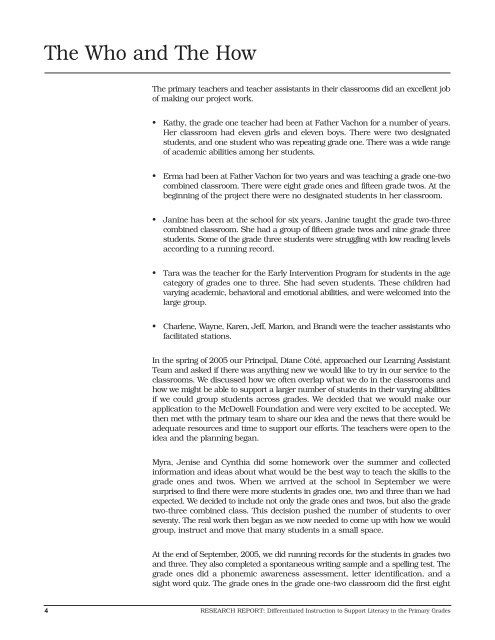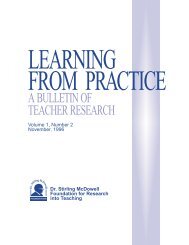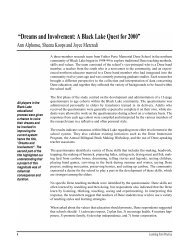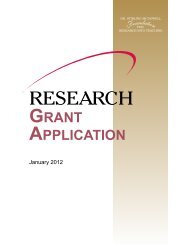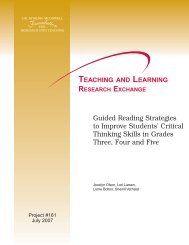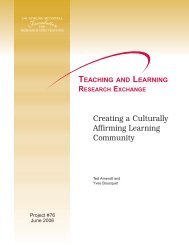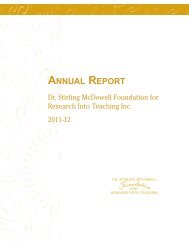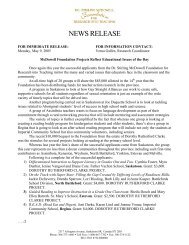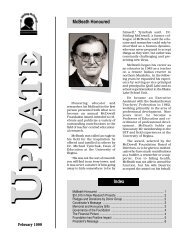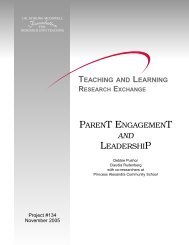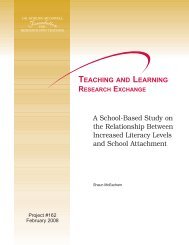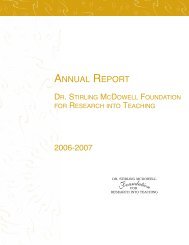Differentiated Instruction to Support Literacy in the Primary Grades
Differentiated Instruction to Support Literacy in the Primary Grades
Differentiated Instruction to Support Literacy in the Primary Grades
You also want an ePaper? Increase the reach of your titles
YUMPU automatically turns print PDFs into web optimized ePapers that Google loves.
The Who and The How<br />
The primary teachers and teacher assistants <strong>in</strong> <strong>the</strong>ir classrooms did an excellent job<br />
of mak<strong>in</strong>g our project work.<br />
• Kathy, <strong>the</strong> grade one teacher had been at Fa<strong>the</strong>r Vachon for a number of years.<br />
Her classroom had eleven girls and eleven boys. There were two designated<br />
students, and one student who was repeat<strong>in</strong>g grade one. There was a wide range<br />
of academic abilities among her students.<br />
• Erma had been at Fa<strong>the</strong>r Vachon for two years and was teach<strong>in</strong>g a grade one-two<br />
comb<strong>in</strong>ed classroom. There were eight grade ones and fifteen grade twos. At <strong>the</strong><br />
beg<strong>in</strong>n<strong>in</strong>g of <strong>the</strong> project <strong>the</strong>re were no designated students <strong>in</strong> her classroom.<br />
• Jan<strong>in</strong>e has been at <strong>the</strong> school for six years. Jan<strong>in</strong>e taught <strong>the</strong> grade two-three<br />
comb<strong>in</strong>ed classroom. She had a group of fifteen grade twos and n<strong>in</strong>e grade three<br />
students. Some of <strong>the</strong> grade three students were struggl<strong>in</strong>g with low read<strong>in</strong>g levels<br />
accord<strong>in</strong>g <strong>to</strong> a runn<strong>in</strong>g record.<br />
• Tara was <strong>the</strong> teacher for <strong>the</strong> Early Intervention Program for students <strong>in</strong> <strong>the</strong> age<br />
category of grades one <strong>to</strong> three. She had seven students. These children had<br />
vary<strong>in</strong>g academic, behavioral and emotional abilities, and were welcomed <strong>in</strong><strong>to</strong> <strong>the</strong><br />
large group.<br />
• Charlene, Wayne, Karen, Jeff, Marion, and Brandi were <strong>the</strong> teacher assistants who<br />
facilitated stations.<br />
In <strong>the</strong> spr<strong>in</strong>g of 2005 our Pr<strong>in</strong>cipal, Diane Côté, approached our Learn<strong>in</strong>g Assistant<br />
Team and asked if <strong>the</strong>re was anyth<strong>in</strong>g new we would like <strong>to</strong> try <strong>in</strong> our service <strong>to</strong> <strong>the</strong><br />
classrooms. We discussed how we often overlap what we do <strong>in</strong> <strong>the</strong> classrooms and<br />
how we might be able <strong>to</strong> support a larger number of students <strong>in</strong> <strong>the</strong>ir vary<strong>in</strong>g abilities<br />
if we could group students across grades. We decided that we would make our<br />
application <strong>to</strong> <strong>the</strong> McDowell Foundation and were very excited <strong>to</strong> be accepted. We<br />
<strong>the</strong>n met with <strong>the</strong> primary team <strong>to</strong> share our idea and <strong>the</strong> news that <strong>the</strong>re would be<br />
adequate resources and time <strong>to</strong> support our efforts. The teachers were open <strong>to</strong> <strong>the</strong><br />
idea and <strong>the</strong> plann<strong>in</strong>g began.<br />
Myra, Jenise and Cynthia did some homework over <strong>the</strong> summer and collected<br />
<strong>in</strong>formation and ideas about what would be <strong>the</strong> best way <strong>to</strong> teach <strong>the</strong> skills <strong>to</strong> <strong>the</strong><br />
grade ones and twos. When we arrived at <strong>the</strong> school <strong>in</strong> September we were<br />
surprised <strong>to</strong> f<strong>in</strong>d <strong>the</strong>re were more students <strong>in</strong> grades one, two and three than we had<br />
expected. We decided <strong>to</strong> <strong>in</strong>clude not only <strong>the</strong> grade ones and twos, but also <strong>the</strong> grade<br />
two-three comb<strong>in</strong>ed class. This decision pushed <strong>the</strong> number of students <strong>to</strong> over<br />
seventy. The real work <strong>the</strong>n began as we now needed <strong>to</strong> come up with how we would<br />
group, <strong>in</strong>struct and move that many students <strong>in</strong> a small space.<br />
At <strong>the</strong> end of September, 2005, we did runn<strong>in</strong>g records for <strong>the</strong> students <strong>in</strong> grades two<br />
and three. They also completed a spontaneous writ<strong>in</strong>g sample and a spell<strong>in</strong>g test. The<br />
grade ones did a phonemic awareness assessment, letter identification, and a<br />
sight word quiz. The grade ones <strong>in</strong> <strong>the</strong> grade one-two classroom did <strong>the</strong> first eight<br />
4 RESEARCH REPORT: <strong>Differentiated</strong> <strong>Instruction</strong> <strong>to</strong> <strong>Support</strong> <strong>Literacy</strong> <strong>in</strong> <strong>the</strong> <strong>Primary</strong> <strong>Grades</strong>


